The Direct Oral Anticoagulants Market is estimated to be valued at USD 32.4 billion in 2025 and is projected to reach USD 66.8 billion by 2035, registering a compound annual growth rate (CAGR) of 7.5% over the forecast period.
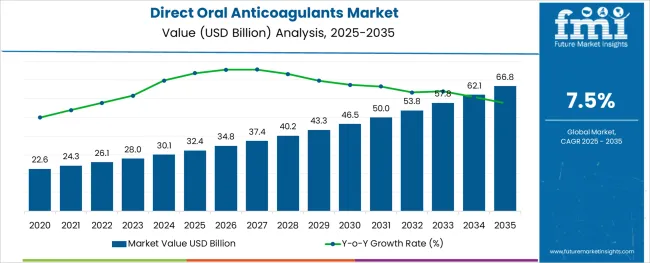
The direct oral anticoagulants market is growing steadily, supported by the increasing prevalence of cardiovascular diseases and advancements in anticoagulation therapies. The rise in atrial fibrillation cases, which heightens the risk of stroke, has led to greater demand for effective and safe oral anticoagulants. Healthcare providers have been focusing on novel treatment options that offer improved patient adherence and reduced monitoring requirements compared to traditional therapies.
Technological innovations in drug formulation and delivery have enhanced the efficacy and safety profiles of these medications. Furthermore, hospital pharmacies remain the primary distribution channel, facilitating timely access for inpatients and outpatients alike.
Growing awareness about stroke prevention and expanding healthcare infrastructure globally are expected to sustain market growth. Segmental momentum is anticipated to be driven by novel oral anticoagulants, atrial fibrillation as the key disease indication, and hospital pharmacies as the dominant distribution channel.
The market is segmented by Product, Disease Indication, and Distribution Channel and region. By Product, the market is divided into Novel Oral Anticoagulant and Warfarin. In terms of Disease Indication, the market is classified into Atrial Fibrillation, Deep Vein Thrombosis (DVT), Pulmonary Embolism (PE), and Heart Attacks. Based on Distribution Channel, the market is segmented into Hospital Pharmacies, Retail Pharmacies, and Online. Regionally, the market is classified into North America, Latin America, Western Europe, Eastern Europe, Balkan & Baltic Countries, Russia & Belarus, Central Asia, East Asia, South Asia & Pacific, and the Middle East & Africa.
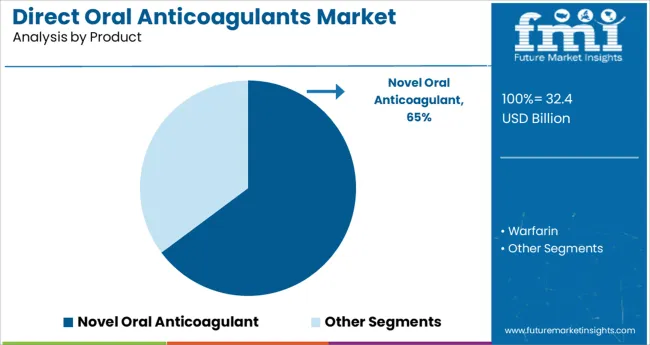
The Novel Oral Anticoagulant segment is projected to hold 64.8% of the market revenue in 2025, establishing it as the leading product type. This segment’s growth is largely due to its advantages over traditional anticoagulants, including predictable pharmacokinetics, fewer food and drug interactions, and a lower risk of bleeding complications.
Medical professionals have increasingly preferred novel oral anticoagulants for their convenience and effectiveness in preventing stroke and systemic embolism. Patient adherence is also improved due to fixed-dosing regimens and a reduced need for routine coagulation monitoring.
These factors have driven widespread adoption across healthcare systems globally, supporting the segment’s continued growth.
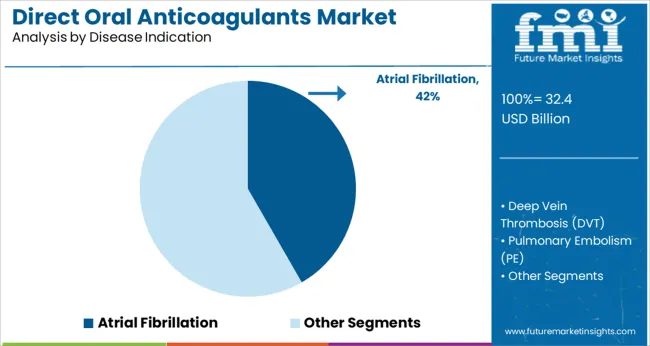
The Atrial Fibrillation segment is expected to account for 41.7% of the direct oral anticoagulants market revenue in 2025, retaining its dominance among disease indications. The segment’s expansion is closely tied to the increasing global burden of atrial fibrillation, a leading cause of stroke.
Anticoagulation therapy is critical in reducing stroke risk in patients with atrial fibrillation, prompting consistent demand for effective oral anticoagulants. Enhanced screening and diagnosis of atrial fibrillation in aging populations have further driven market growth.
Healthcare initiatives aimed at improving stroke prevention and patient education have contributed to the broader adoption of therapy within this segment.
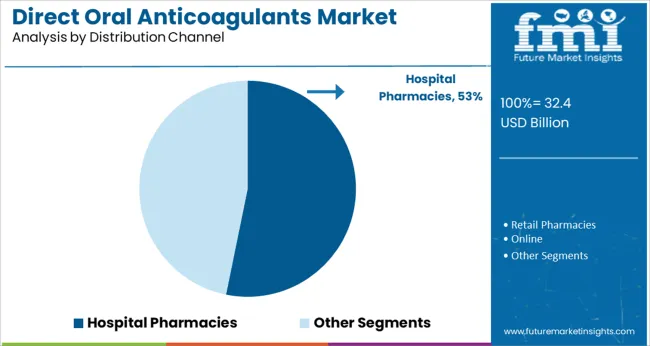
The Hospital Pharmacies segment is projected to hold 53.2% of the market revenue in 2025, maintaining its position as the primary distribution channel. This segment’s growth has been driven by hospitals’ role in initiating and managing anticoagulant therapies, ensuring appropriate dosing and monitoring.
Hospital pharmacies offer centralized procurement and dispensing, facilitating efficient supply chain management and ensuring patient access. Integration with hospital electronic health records and clinical protocols supports safe and effective use of oral anticoagulants.
The segment benefits from strong collaborations between healthcare providers and pharmacy services, reinforcing its leadership in medication distribution. As hospitals continue to be focal points for anticoagulation management, hospital pharmacies will remain critical in delivering these therapies.
The demand for direct oral anticoagulants as a first-line treatment for venous thromboembolism and atrial fibrillation is projected to drive the global direct oral anticoagulants market. In the near future, the direct oral anticoagulants market will be boosted by the FDA's growing approval and the CE mark for direct oral anticoagulants.
In the forecast period, rising incidences of thrombosis, which is a leading cause of morbidity and mortality in various areas of the world, are likely to fuel the sales of direct oral anticoagulants.
However, there are a number of factors that may limit the sales of direct oral anticoagulants, including their higher cost as compared to warfarin and their shorter acting dosage, which necessitates strict adherence to dosing schedules.
Furthermore, rigorous drug development rules are expected to limit the demand for direct oral anticoagulants.
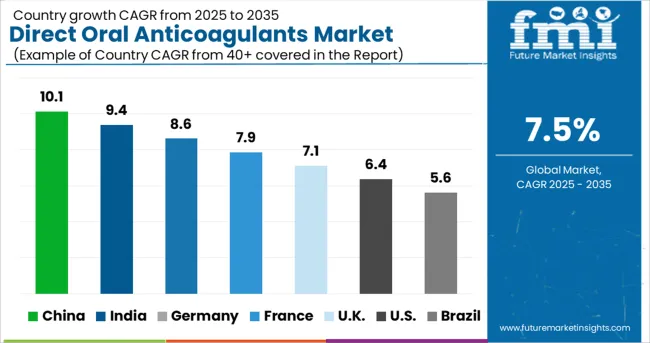
Due to the rapid uptake of novel direct oral anticoagulants and the rise in atrial fibrillation patients treated with anticoagulants, North America is likely to account for a significant direct oral anticoagulants market share. The demand for direct oral anticoagulants in North America is predicted to grow as the number of operations and the frequency of chronic disease rises.
Due to increasing permission for drug development, Europe is predicted to provide the second highest direct oral anticoagulants market share worldwide, with significant growth. The sales of direct oral anticoagulants is projected to be driven by a growing focus on the development of innovative coagulation therapies.
The Asia Pacific market is primarily driven by factors, such as rising cancer incidence and venous thrombosis risk. The demand for direct oral anticoagulants is likely to be driven by rising awareness of new therapies and increased usage due to a large patient pool in emerging economies such as India and ASEAN countries.
Due to advancements in novel therapies and the expanding presence of important manufacturers, China is projected to see substantial growth in sales of direct oral anticoagulants. Due to a lack of awareness and limited acceptance due to the high price of direct oral anticoagulants, the market in Latin America, the Middle East and Africa is likely to slow down in sales of direct oral anticoagulants.
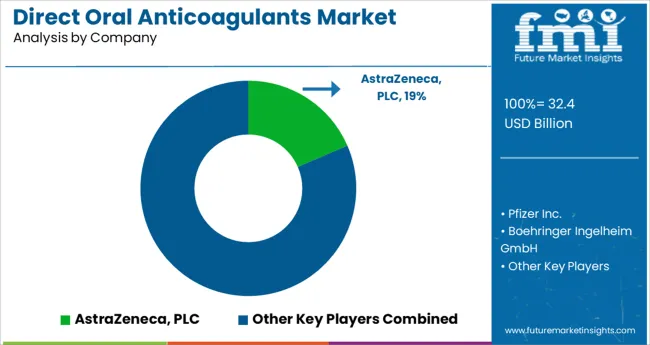
Some of the key players present in the global direct oral anticoagulants market are Pfizer Inc, Teva Pharmaceutical Industries Ltd, Boehringer Ingelheim Pharmaceuticals, Inc, Janssen Pharmaceuticals, Inc, Bayer AG, Bristol-Myers Squibb Co, Pab Organics Private Limited, Daiichi Sankyo Company, Limited, among others, holding a substantial direct oral anticoagulants market share.
| Report Attribute | Details |
|---|---|
| Growth rate | CAGR of 7.5% from 2025 to 2035 |
| Base year for estimation | 2024 |
| Historical data | 2020 to 2024 |
| Forecast period | 2025 to 2035 |
| Quantitative units | Revenue in billion, volume in kilotons and CAGR from 2025 to 2035 |
| Report coverage | Revenue forecast, volume forecast, company ranking, competitive landscape, growth factors and trends, Pricing Analysis |
| Segments covered | Drug type, distribution channel, region |
| Regional scope | North America; Western Europe; Eastern Europe; Middle East; Africa; ASEAN; South Asia; Rest of Asia; Australia and New Zealand |
| Country scope | USA, Canada, Mexico, Germany, UK, France, Italy, Spain, Russia, Belgium, Poland, Czech Republic, China, India, Japan, Australia, Brazil, Argentina, Colombia, Saudi Arabia, UAE, Iran, South Africa |
| Key companies profiled | Pfizer Inc; Teva Pharmaceutical Industries Ltd; Boehringer Ingelheim Pharmaceuticals, Inc; Janssen Pharmaceuticals, Inc; Bayer AG; Bristol-Myers Squibb Co; Pab Organics Private Limited; Daiichi Sankyo Company; Limited; among others |
| Customization scope | Free report customization (equivalent to up to 8 analysts working days) with purchase. Addition or alteration to country, regional & segment scope. |
| Pricing and purchase options | Avail customized purchase options to meet your exact research needs. |
The global direct oral anticoagulants market is estimated to be valued at USD 32.4 billion in 2025.
It is projected to reach USD 66.8 billion by 2035.
The market is expected to grow at a 7.5% CAGR between 2025 and 2035.
The key product types are novel oral anticoagulant and warfarin.
atrial fibrillation segment is expected to dominate with a 41.7% industry share in 2025.






Our Research Products

The "Full Research Suite" delivers actionable market intel, deep dives on markets or technologies, so clients act faster, cut risk, and unlock growth.

The Leaderboard benchmarks and ranks top vendors, classifying them as Established Leaders, Leading Challengers, or Disruptors & Challengers.

Locates where complements amplify value and substitutes erode it, forecasting net impact by horizon

We deliver granular, decision-grade intel: market sizing, 5-year forecasts, pricing, adoption, usage, revenue, and operational KPIs—plus competitor tracking, regulation, and value chains—across 60 countries broadly.

Spot the shifts before they hit your P&L. We track inflection points, adoption curves, pricing moves, and ecosystem plays to show where demand is heading, why it is changing, and what to do next across high-growth markets and disruptive tech

Real-time reads of user behavior. We track shifting priorities, perceptions of today’s and next-gen services, and provider experience, then pace how fast tech moves from trial to adoption, blending buyer, consumer, and channel inputs with social signals (#WhySwitch, #UX).

Partner with our analyst team to build a custom report designed around your business priorities. From analysing market trends to assessing competitors or crafting bespoke datasets, we tailor insights to your needs.
Supplier Intelligence
Discovery & Profiling
Capacity & Footprint
Performance & Risk
Compliance & Governance
Commercial Readiness
Who Supplies Whom
Scorecards & Shortlists
Playbooks & Docs
Category Intelligence
Definition & Scope
Demand & Use Cases
Cost Drivers
Market Structure
Supply Chain Map
Trade & Policy
Operating Norms
Deliverables
Buyer Intelligence
Account Basics
Spend & Scope
Procurement Model
Vendor Requirements
Terms & Policies
Entry Strategy
Pain Points & Triggers
Outputs
Pricing Analysis
Benchmarks
Trends
Should-Cost
Indexation
Landed Cost
Commercial Terms
Deliverables
Brand Analysis
Positioning & Value Prop
Share & Presence
Customer Evidence
Go-to-Market
Digital & Reputation
Compliance & Trust
KPIs & Gaps
Outputs
Full Research Suite comprises of:
Market outlook & trends analysis
Interviews & case studies
Strategic recommendations
Vendor profiles & capabilities analysis
5-year forecasts
8 regions and 60+ country-level data splits
Market segment data splits
12 months of continuous data updates
DELIVERED AS:
PDF EXCEL ONLINE
Oral Anticoagulants Market
Direct Liquid Cooling IGBT Module Market Size and Share Forecast Outlook 2025 to 2035
Oral Bone Implant Material Market Size and Share Forecast Outlook 2025 to 2035
Oral Solid Dosage Pharmaceutical Formulation Market Size and Share Forecast Outlook 2025 to 2035
Direct Fast Dyes Market Size and Share Forecast Outlook 2025 to 2035
Direct Thermal Printing Film Market Size and Share Forecast Outlook 2025 to 2035
Directional Drilling Service Market Forecast Outlook 2025 to 2035
Direct Methanol Fuel Cell Market Size and Share Forecast Outlook 2025 to 2035
Oral Dosing Cup Market Forecast AND Outlook 2025 to 2035
Direct Operated Poppet Valve Market Forecast and Outlook 2025 to 2035
Direct to Garment Printing Market Size and Share Forecast Outlook 2025 to 2035
Oral Care Chemicals Market Size and Share Forecast Outlook 2025 to 2035
Oral Irrigator Market Size and Share Forecast Outlook 2025 to 2035
Direct Burial Fiber Optic Cable Market Size and Share Forecast Outlook 2025 to 2035
Directed Energy Weapons Market Size and Share Forecast Outlook 2025 to 2035
Oral Antiseptics Market Size and Share Forecast Outlook 2025 to 2035
Oral Food Challenge Testing Market Analysis Size and Share Forecast Outlook 2025 to 2035
Direct To Chip Liquid Cooling Market Size and Share Forecast Outlook 2025 to 2035
Oral Care Market Growth – Demand, Trends & Forecast 2025–2035
Direct Write Semiconductor Market Size and Share Forecast Outlook 2025 to 2035

Thank you!
You will receive an email from our Business Development Manager. Please be sure to check your SPAM/JUNK folder too.
Chat With
MaRIA